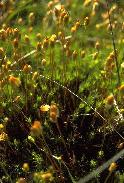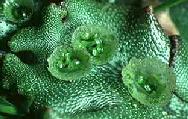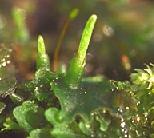Bryophytes
Reminder: Clicking on the picture will take you to the site where I originally found it.
The bryophytes are a simple form of plant. Most are small and not very noticeable. They are interesting because they resemble the green algae, but which characteristics which put them clearly in a class (oops... division) by themselves.
There are three main types of bryophytes:
-
Anthocerotophyta (Hornworts)
- Bryophyta (Mosses)
- Marchantiophyta (Liverworts)
All bryophytes have certain characteristics. They lack vascular tissue. In plain English, they don't have tubes inside of them which move water and nutrients around. You won't find leaf veins in these plants and you'll have a hard time finding leaves at all. This is because they have a simple body plan.
Bryophytes have an unusual life history. Each plant undergoes an alternation of generations *. This means that one generation of the plant will be able to reproduce sexually, and the next will only be able to reproduce asexually. Ack, this is getting complicated. Please read the illustration for more details.
One characteristic of bryophytes is that they have no roots. Yank up some moss and see. It is anchored down with rhizomes, which are more like stems than roots. Bryophytes are very good at breaking down rocks and hard srfaces, which is great for the other plants in the neighborhood. You can see mosses clinging to trees and rocks in the forest.
 Speaking of mosses, they're the most common and best known of the bryophytes. Mosses can grow on almost any surface, but they need moisture to grow well.
Speaking of mosses, they're the most common and best known of the bryophytes. Mosses can grow on almost any surface, but they need moisture to grow well.
Mosses reproduce sexually and asexually. To reproduce sexually, they need a lot of water. Moss produces eggs and sperm. The eggs are stationery, and the sperm must swim to reach them. This can only happen under high-water conditions.
You may have heard it said that moss will only grow on the north side of trees. Actually, there's nothing magic about the north side. Probably, the north side gets less sunlight and doesn't dry out as quickly, so the mosses have more moisture. In the southern hemisphere, it's probably opposite.
 The second most common bryophyte is the liverwort. This is another example of a tragically named plant. Who wants a liverwort? Actually, I would love to have one.
The second most common bryophyte is the liverwort. This is another example of a tragically named plant. Who wants a liverwort? Actually, I would love to have one.
Liverworts are named for their shape, which is said to resemble a liver. In my opinion, a liver is just an oblong blob. These are small plants who live in moist, temperate climates. They usually grow among mosses, so unless you're paying attention, you may not see them.
The life cycle of the liverwort is very much like the moss. The gametophyte (male and female) structures of this plant are pretty cool though. They resemble little umbrellas.
During a dry spell, the liverworts may shrivel up completely. They aren't dead, but will re-emerge in the next rain.
 Hornworts aren't well known. They resemble the liverworts in outer appearance only. When you look at the details, they're completely different.
Hornworts aren't well known. They resemble the liverworts in outer appearance only. When you look at the details, they're completely different.
While most plants hava a lot of little chloroplasts in each cell, hornworts only have one, but it's a big one. They're very easy to identify under a microscope for this reason. Also, the sporophyte (spore producing) generation looks very different from the liverworts. In liverworts, it looks like a stalk with a knob at the end, but in hornworts, there is only has a stalk.
Like the other bryophytes, hornworts reproduce sexually and asexually. They're found in moist, temperate places and can grow on hard surfaces. Look for them where you see moss!
On to vascular spore-bearing plants,
visit the gymnosperms,
peek at the angiosperms,
back to the main plant page, or
return to the overview.
 Speaking of mosses, they're the most common and best known of the bryophytes. Mosses can grow on almost any surface, but they need moisture to grow well.
Speaking of mosses, they're the most common and best known of the bryophytes. Mosses can grow on almost any surface, but they need moisture to grow well.  The second most common bryophyte is the liverwort. This is another example of a tragically named plant. Who wants a liverwort? Actually, I would love to have one.
The second most common bryophyte is the liverwort. This is another example of a tragically named plant. Who wants a liverwort? Actually, I would love to have one. Hornworts aren't well known. They resemble the liverworts in outer appearance only. When you look at the details, they're completely different.
Hornworts aren't well known. They resemble the liverworts in outer appearance only. When you look at the details, they're completely different.